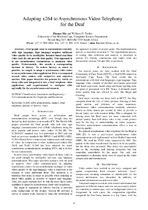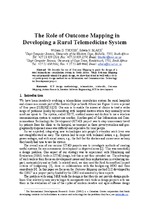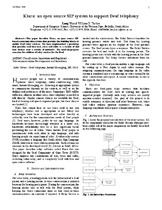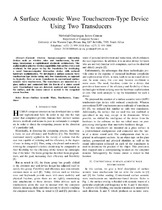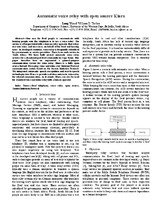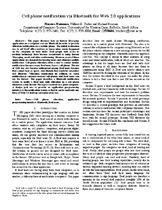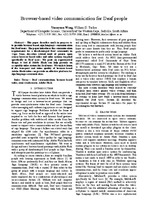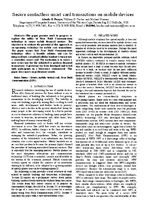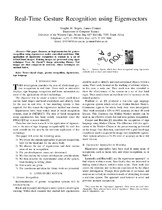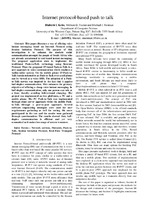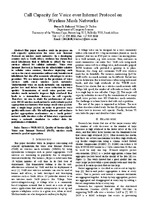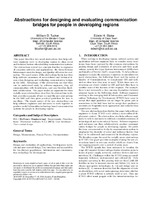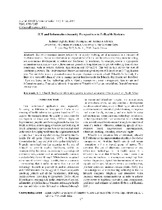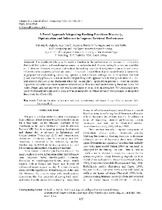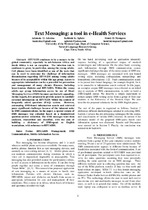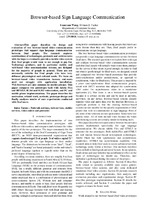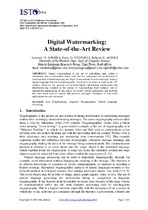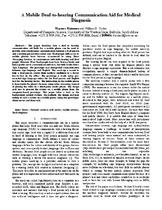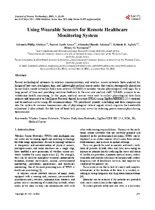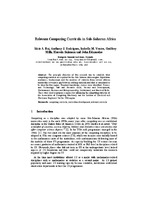Browsing Computer Science by Issue Date
Now showing items 41-60 of 171
-
Adapting x264 to asynchronous video telephony for the Deaf
(Telkom, 2008)Deaf people want to communicate remotely with sign language. Sign language requires sufficient video quality to be intelligible. Internet-based real-time video tools do not provide that quality. Our approach is to use ... -
The role of Outcome Mapping in developing a rural telemedicine system
(International Information Management Corporation, 2008)We describe the use of Outcome Mapping to guide the design of a rural telemedicine consultation system in South Africa. While Outcome Mapping was not primarily intended to guide design, we show that it tied in well with a ... -
Kiara: an open source SIP system to support Deaf telephony
(Telkom, 2008)This paper describes Kiara, an open source SIPbased communication system that provides the building blocks to enable Deaf relay services. We have implemented a prototype that provides real-time text, voice and video to a ... -
A surface acoustic wave touchscreen-type device using two transducers
(2008)Current wireless human-computer interaction devices such as wireless mice and touchscreens, by and large, incorporate a sophisticated electronic architecture. The sophistication achieves wireless capabilities but carries ... -
Automatic voice relay with open source Kiara
(Telkom, 2009)One way for Deaf people to communicate with hearing people over the telephone is to use a voice relay. The service is often provided with a human relay operator that relays text into voice, and vice versa, on behalf of the ... -
Cell phone notification via bluetooth for Web 2.0 applications
(Telkom, 2009)This paper discusses how an Instant Messaging application on a computer can use Bluetooth in order to provide vibration notification on a mobile phone. The initial motivation was to aid Deaf1 office workers to know when ... -
Browser-based video communication for deaf people
(Telkom, 2009)This paper describes work in progress to to provide browser-based sign language communication for deaf users. The paper introduces the communication requirements for a disadvantaged Deaf community in Cape Town, describes ... -
Secure contactless smart card transactions on mobile devices
(Telkom, 2009)This paper presents work in progress to explore the utility of Near Field Communication technology to secure mobile financial services. The objective is to evaluate the potential of this approach as an upcoming technology ... -
Real-time gesture recognition using eigenvectors
(2009)This paper discusses an implementation for gesture recognition using eigenvectors under controlled conditions. This application of eigenvector recognition is trained on a set of defined hand images. Training images are ... -
Internet protocol-based push to talk
(Telkom, 2010)This paper discusses a way of offering voice instant messaging based on Internet Protocol using Session Initiation Protocol. The purpose of this investigation is to enhance the modern social communication amongst the people ... -
Call capacity for voice over Internet Protocol on wireless mesh networks
(Telkom, 2010)This paper describes work in progress on call capacity optimization for voice over Internet Protocol on wireless mesh networks. In a developing country such as South Africa, evidence has shown that rural inhabitants find ... -
Abstractions for designing and evaluating communication bridges for people in developing regions
(ACM, 2010)This paper describes two novel abstractions that help soft- ware engineers work in developing regions to align social and technical factors when building communication systems. The abstractions extend two concepts familiar ... -
ICT and information security perspectives in E-Health Systems
(Medwell Journals, 2010)This study examines issues pertinent to the rapidly evolving use of information as a currency of modern economies. Access to information has important benefits that can be achieved in many areas including, social-economic ... -
A novel approach integrating ranking functions discovery, optimization and infernce to improve retrieval performance
(Medwell Journals, 2010)The significant roles play by ranking function in the performance and success of Information Retrieval (IR) systems and search engines cannot be underestimated. Diverse ranking functions are available in IR literature. ... -
Text Messaging a tool in e-Health services
(Telkom, 2010)HIV/AIDS continues to be a menace to the global community, especially in sub-Saharan Africa and South Africa is not an exception. The infection rate is continues to grow, in particular, among the young adults. Cell ... -
Browser-based sign language communication
(Telkom, 2010)This paper describes the design and evaluation of two browser-based video communication prototypes that support sign language communication between Deaf people. The research explores combinations of technologies, protocols ... -
Digital watermarking: a state-of-the-art review
(IIMC International Information Management Corporation, 2010)Digital watermarking is the art of embedding data, called a watermark, into a multimedia object such that the watermark can be detected or extracted later without impairing the object. Concealment of secret messages inside ... -
A mobile Deaf-to-hearing communication aid for medical diagnosis
(Telkom, 2010)This paper describes how a deaf to hearing communication aid built for a mobile phone can be used to provide semi-synchronous communication between a Deaf person and a hearing person who cannot sign. Deaf people with access ... -
Using wearable sensors for remote healthcare monitoring system
(Scientific Research Publishing, 2011)Recent technological advances in wireless communications and wireless sensor networks have enabled the design of low-cost, intelligent, tiny, and lightweight medical sensor nodes that can be strategically placed on human ... -
Relevant computing curricula in Sub-Saharan Africa
(2011)The principle objective of this research was to establish what computing curricula are required for the Sub-Saharan Africa region. Input from academics, businessmen and the analyses of curricula from several African ...

